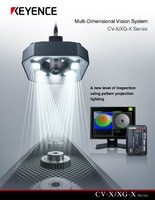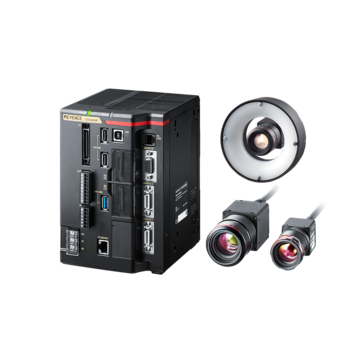Vision Systems
- Vision System with Built-in AI VS series
- Intuitive Vision System CV-X series
- Customizable Vision System XG-X series
- GigE camera and lighting for PC-based machine vision VJ series
- Inline 3D Inspection 3D Vision series
- 3D Vision-Guided Robotics 3D VGR series
- Line Scan Technology Line Scan series
- 2D Vision-Guided Robotics 2D VGR series
- LED Lighting CA-D series
- Lenses (for Machine Vision) CA-L series
- Machine Vision System Database VisionDatabase series
Advantages of 3D Machine Vision Systems
Machine vision systems capable of providing 3D data have traditionally been very expensive, complicated to install, difficult to maintain, and almost impossible to operate without trained staff. However, technology is making massive leaps at faster rates than ever before, with innovations that were once unaffordable becoming increasingly accessible to businesses.
Machine vision is one such technology, and while it can be traced back to the 1950s, the emergence of more affordable 3D machine vision systems is happening right now. It's continuously revolutionizing the modern industry. With AI and machine learning integration, we're slowly leaning towards Industry 4.0.
In short, 3D vision technology facilitates 3D measurement or inspection of 3D surfaces and objects with great precision. These systems capture dimensional data from all possible angles, process and combine the data, and output a highly accurate visual representation of the observed object.
3D machine vision applications are vast since these systems are capable of more than just product and quality control. They can help guide robots in assembly lines and storage spaces, are great for object recognition and tracking, and excel in inspection and quality control.
So, let's discuss what a 3D machine vision system is, the various advantages offered by 3D machine vision systems, and how the advantages of 3D machine vision systems continue to revolutionize modern industry.
Precise Measurements and Inspection
Precise measurements and inspection are among the primary advantages of 3D machine vision systems, as they enable manufacturers to perform these tasks with increased accuracy and repeatability. Traditional quality control, which involves both precise measurements and inspection, implies human error and numerous inconsistencies. Human talents and labor can be delegated to other areas of the manufacturing process, while routine inspection and precise measurements can be delegated to a 3D machine vision system.
The precision, speed, and reliability of 3D machine vision systems allow them to capture data more accurately, in real-time, and at higher sampling speeds. This not only facilitates a faster operation but also faster inspection and measurements. The software is capable of detecting defects, like cold solder joints on an electronic circuit PCB, which, in most cases, isn't visible to the naked human eye.
However, the precision of 3D machine vision systems isn't limited to defect detection alone, and their precise measurement capabilities are often used in scanning and making digital representations of real-life objects.
Streamlines Defect Checks
Due to their incredibly high precision and the ability to interpret and "see" different data, 3D machine vision systems are used to streamline defect checks across a variety of different industries. For example, the use of advanced cameras and sensors delegated to capturing three-dimensional data also facilitates accurate measurements.
This is particularly interesting in machining applications, especially for small parts that might be machined en masse. Other applications might include the inspection of PCB circuitry, component alignment, and presence-absence checks.
In other words, one of the 3D machine vision systems benefits is that they quickly check whether all the components are soldered onto the PCB, how they're aligned, and whether the solder joints are complete. This could take a human inspector minutes, or perhaps even hours, to perform by hand, depending on the complexity of the circuit.
This increases the overall effectiveness of the production process, as only those products flagged as defects would be sent or marked for further inspection. Some high-end systems will also attach a defect description, making the job of a human inspector much easier.
Robot Guidance
The ability to read and process different data in real-time while coordinating with other system components is another advantage of 3D machine vision systems, finding many applications in the field of robot guidance. This doesn't apply to commercial robot vacuums; the technology found its place in industrial robots, autonomous vehicles, and advanced robotic assistants.
The various advantages of 3D machine vision systems provide industrial robots with precision and flexibility, as they enable robots to identify and manipulate parts and components of various shapes and sizes and in vastly different lighting conditions.
Robot guidance and 3D machine vision systems also ensure safety in applications where humans work with collaborative robots, as they allow robots to understand and adapt to their surroundings. That same guidance is essential for the safe navigation of autonomous vehicles, as it allows the vehicle to understand its surroundings in three dimensions.
This recognition of objects is crucial for distance gauging, path planning, obstacle avoidance, and real-time decision-making, which is vital for a vehicle's functioning. Admittedly, these systems combine 3D machine vision systems with other technologies, such as LIDAR, radar, and ultrasonic sensors, to create a comprehensive and redundant system for passenger safety.
FAQs about 3D Machine Vision Systems
What is a 3D Machine Vision System?
As stated above, 3D machine vision systems are used across various industries for automated inspection, measurement, and guidance tasks. These systems capture 2D images and point cloud data, and combine them into 3D data suitable for further processing and analysis.
How Does 3D Machine Vision Work?
3D cameras are capable of capturing the depth and contours of objects via laser triangulation, structured light, time-of-flight, or stereo vision techniques to obtain 3D images. The processing unit and software process the captured images using software algorithms that analyze the data and extract meaningful information about the object's measurements and surface features.
What are the Uses of 3D Machine Vision?
Many industrial applications and processes benefit from the use of 3D machine vision systems, but they're mostly used for quality control and inspection, robot guidance, and precise measurements.
What are the Differences Between 2D and 3D Vision Systems?
A 3D machine vision system can sense and understand space and objects in three dimensions, as well as extrapolate the necessary data about the shape, size, and position of objects it detects. 2D machine vision systems only rely on 2D images and 2D imaging techniques, and while they're also widespread in metrology, they need to understand the space around them.


